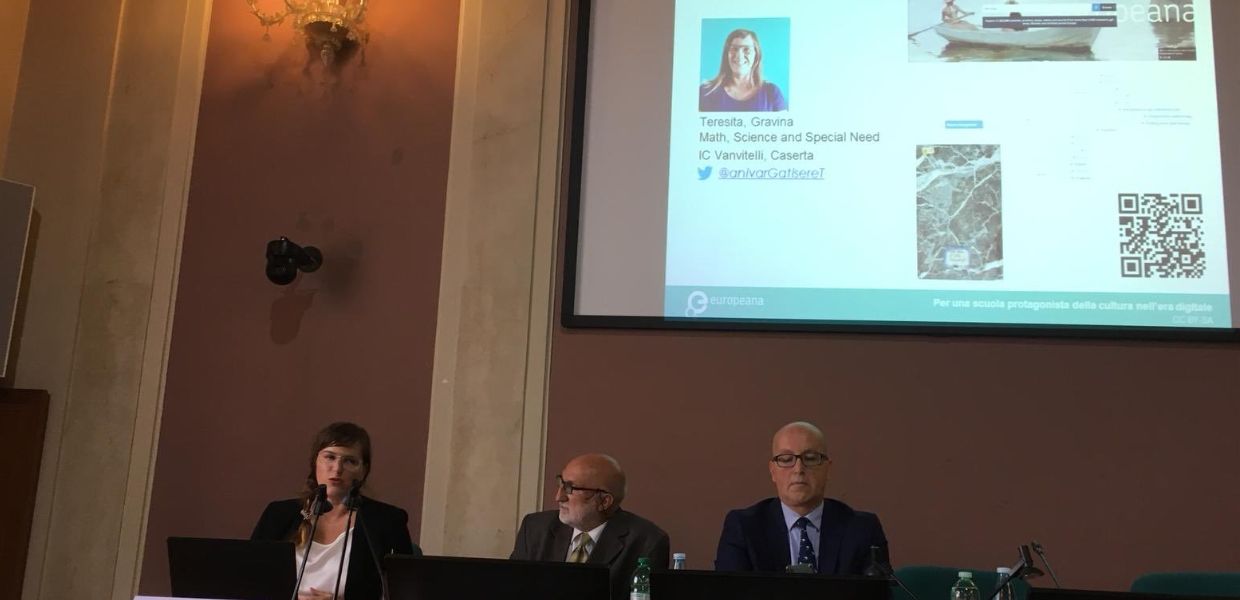Can you tell us a bit about yourself?
I am a geologist working as a Science and Maths teacher in a junior high school in Italy. I am also the Italian ambassador for Europeana. The Europeana Teacher Ambassador network is coordinated by Europeana Schoolnet and consists of 12 Europeana ambassadors from 12 different countries and one Ambassador for the European Schools, working with supporting education ministries. Our main goal is the promotion and adoption of Europeana resources for education at national levels.
For the last two years, I have been using Europeana resources in my teaching activities, in particular related to STEM. I am strongly convinced that digital cultural heritage is very important because it provides the opportunity for students to learn about their European cultural background and became a future European citizen.
What is the most valuable aspect of your work as a Europeana Teacher Ambassador?
The most valuable aspect is the collaboration with other European teachers (the other 12 Ambassadors) with very different backgrounds and with the Italian teacher user group (10 teachers creating and testing learning material using digital cultural heritage content). I learn about teaching other subjects and about teaching students from different grades.
The collaboration with the teacher from the Italian user group was valuable, we had time to discuss teaching activities designed using Europeana resources.
This project gave me time to talk to other teachers about how to realise teaching activities with Europeana resources. This is very important in a teacher’s professional development but not always possible in our time at school, because we are required to prioritise other aspects of teaching. Collaborating with people with different cultural backgrounds and professional experience is fundamental to being able to take full advantage of the great number of resources available on Europeana Collections.
You can see the results of our work in the Teaching With Europeana blog. The amazing ideas gathered from the ambassadors and user group were generated in a powerful year-long brainstorm.
In addition, it was great to see Europeana included in In Prima Fila, an Italian textbook about implementing practical activities about music.
What are the challenges in making digital culture widely used in education in your experience?
First of all, we need a change of mentality in teaching. We have to take into account that digital is becoming more important in our society every day and this is true also with culture. Digitalisation gives us new ways to enjoy cultural heritage, and it is important to underline this aspect of teaching activity. Digital culture opens up new ways to enrich lessons and possibilities for our students in terms of their background and future job opportunities. Europeana is an important tool for convincing teachers that they can use digital culture in teaching activity. When you explain the aims of the project they easily recognise the relevance of the platform in education. The Europeana Collections website is very easy to navigate, so even my not-so-digital colleagues could get involved.
In order to help my colleagues to learn about digital culture, I have been sharing my experience in using Europeana in teacher training and conferences. Last September I presented a science teaching activity built with Europeana resources at the national congress of Italian Geological Society, in the session dedicated to teaching geoscience at school. I also presented Europeana in teacher training in my city and in an international teacher workshop.
In June, I am going to present Europeana at a literary festival in Salerno, I think this will be an amazing experience because I am going to talk with teachers and science education university students, so I will have the opportunity to present to two different generations of teachers!
Thanks to Europeana, I had the pleasure to talk about activities I’d created with my students in a conference about digital cultural heritage organised by the DiCulther network held at the Italian Ministry of Education. This was an amazing experience because me and my colleague Fulvia Piccolo were the only two teachers talking to policymakers and researchers about our experience in the classroom. I am very proud to have had the opportunity to explain my teacher’s point of view to other figures involved in education.
What are the next steps for the Ambassadors and your involvement with the Europeana Education project?
Next year, in coordination with European Schoolnet, we plan to go on with our Ambassador activities, doing more webinars, spreading the word in Italy and creating more material to use in class.
I personally would love to engage as many teachers as possible in using Europeana, in particular STEM teachers who, due to their background, do not find it so easy to incorporate digital cultural heritage into their teaching activity. And I would also love to engage students in visiting Europeana Collections, because digital cultural heritage gives them the opportunity to learn about our past in order to build the future Europe.




